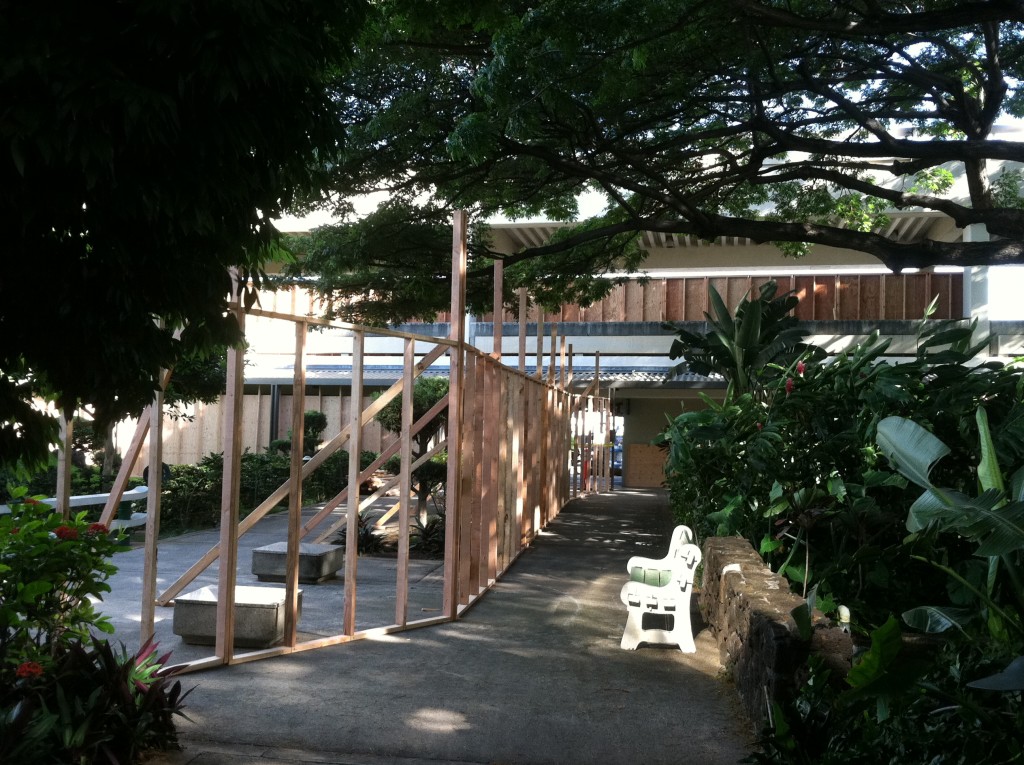
Gardens Gone? The iconic gardens at Honolulu International Airport international terminal may soon be no more than a memory. The three gardens and their ponds – landscaped in the styles of China, Japan, and Hawai`i – have long been a sanctuary for weary travelers seeking relief from the commercial bustle of the terminal’s concourses.
But recently, construction on both the concourse and garden levels suggests this bit of nature may not last much longer. On the concourses leading from the main terminal to the gates, high plywood screens shielded the gardens from the view of travelers. On the garden level itself, in front of the area that used to house the American Airlines lounge, workers were erecting framing that, according to one worker, would be part of a future commercial area.
Elsewhere in the garden area, benches suffer from neglect: slats between concrete standards appear to have been painted most recently in the last century, while the benches themselves wobble on a crumbling foundation. The once-manicured gardens are unkempt and overgrown. Sidewalks are unswept and untidy. The view through dirty glass into the darkened rooms that used to house swank airline clubs reveals furniture and lamps shoved against the walls.
Emails to the airports administrator of the state Department of Transportation, asking for information about the construction work, had not been answered or even acknowledged by press time.
— Patricia Tummons
FIT Program Shapes Up: If the Hawaiian Electric companies’ net metering program for solar photovoltaic systems has been too successful, its feed-in tariff (FIT) program — which covers solar PV, wind, and concentrated solar power — has been the opposite. According to a September status report submitted to the state Public Utilities Commission, only a little over 20 megawatts of renewable energy has been installed under the FIT program, which launched five years ago. That’s only a quarter of the total number of MW allowed under the program.
It was hoped that the program’s terms guaranteeing grid access and set rates for power for 20 years would spur rapid development of renewable energy projects. But the program suffered early on as developers grappled with expensive interconnection studies imposed by the utilities, as well as with lackadaisical, speculative or unprepared applicants who clogged up the program’s active and reserve queues.
In 2013, the PUC issued an order that resulted in dozens of projects being purged. Then late last year, the PUC issued another order aimed at further cleaning up the queues, which by December had grown to include nearly 180 applicants. The commission eliminated the reserve queue, which had 64 applicants, and set deadlines by which applicants in the active queue must prove their projects are “shovel-ready,” among other things.
Some parties to the FIT docket, including Blue Planet Foundation and the state Department of Business, Economic Development, and Tourism, opposed the elimination of the reserve queue, arguing that the move would discourage renewable energy development. But since the PUC’s order, the completion of FIT projects has actually ramped up a bit. Nearly a third of the total MW installed under the program occurred since December. At this rate, it would be another five years before the program’s cap of 80 MW statewide is reached.
–Teresa Dawson
Volume 25, Number 7 November 2015


Leave a Reply